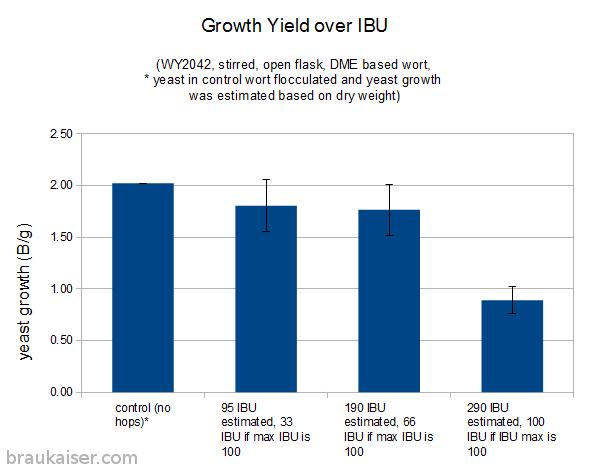In this experiment I looked at the influence that iso-alpha acids have on yeast growth. This was motivated by curiosity and the fact that there are a number of brewers, like me, who are using leftover wort from brewday for future starters.
Setup
For this experiment I prepared 500 ml of unhopped wort and 500 ml of heavily hopped wort. Both worts had an initial extract content of about 11 Plato. The hopped wort was boiled for 30 min with the addition of 4 g of German Magnum (13% alpha acid) pellets. The unhopped wort was also boiled for the same amount of time.
According to the Tinseth IBU model the hopped wort should have 290 IBU, but it is likely that the actual IBU number is less due iso-alpha acid solubility and or isomerization limitations.
By mixing these two worts starters with increasing bitterness were created ranging from
- 100% unhopped wort
- 67% unhopped and 33% hopped wort
- 33% unhopped and 67% hopped wort
- 100% hopped wort
All starters were inoculated with 4 ml of yeast slurry from the same yeast culture. The initial cell density was estimated as 0.05 B/g, which is fairly low. All starters were left open and stirred at 20 C.
Yeast dry weight was determined by filtering a known amount of well suspended yeast in starter beer through 1 micron nominal filter paper. The filtered beer was clear which means that all yeast was held back by the paper. The paper and yeast was then dried using a microwave until all water was removed from the yeast. The paper and dried yeast was the weighed using a balance scale with a resolution of 0.01 g.
Results
The chart below shows the growth as B/g for the 4 different starters
Because the yeast in the control flocculated and made counting difficult its yeast count was estimated using the dry weight of a filtered amount of suspended starter assuming 20 Billion per gram. I’m fairly confident that this is correct since the the yeast from the 33% and 65% hopped wort starter both had a dried yeast cell density of ~ 20 B/g which also matches previous dried yeast measurements for WY 2042.
Yeast from the 100% hopped wort starter showed with 14 B/g slightly less cells per dried weight but the overall yield in yeast biomass was still less than the yield in less hoppy starters.
When looking at the biomass yield there is a constant decline as the IBU level of the starter wort is increased.
Conclusion
While hopped wort has a negative effect on yeast growth it is only significant at very high hopping levels. Thus the use of Pale Ale, Pilsner and even most IPA worts for brewing yeast propagation should not pose any problems. Very highly hopped worts may show a noticeable decline in yeast growth and are thus less well suited for yeast propagation.



